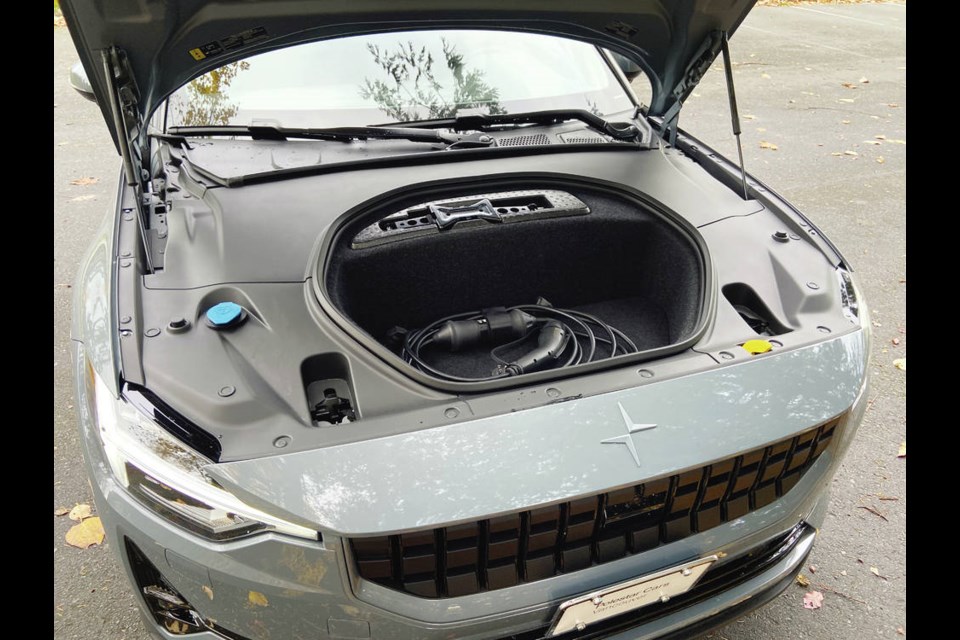The all-electric 2021 Polestar 2 is the new poster child for the luxury segment of the automotive market.
With a starting price of $69,900, the Polestar 2 is a five-door hatchback close in size and price to the successful Tesla Model 3.
The Polestar 2 is a fairly conventional design, and it shares Volvo’s Compact Modular Architecture platform. It can carry up to five occupants and 440 litres of cargo front and rear. (Although there is storage in the front, it is limited in size and capacity.)
But inside the car, a driver will find many features that are far from conventional.
If you are looking for an eco-friendly statement, the Polestar 2 might be the new benchmark, with seats made from a moisture and dirt-resistant plant-based material (leather is available), wood trim that is made of reconstructed wood and carpeting made from recycled water bottles.
That the interior is as luxurious as any of its competitors is a testament to its Scandinavian designers.
Luxury vehicles these days bristle with technology and connectivity, but the Polestar 2 features a trump card — Android Automotive.
Unlike Android Auto, which runs off your cellphone, Android Automotive is an operating system that is fully integrated with the vehicle.
An 11.3-inch centre touchscreen, much like a computer tablet in portrait mode, dominates the centre console. A driver has to merely point and swipe at tiles to access applications the system controls.
But the Android Automotive game-changer is that it controls the car’s systems, not just the entertainment system and telephone.
Using a voice command through Google Assistant, you can change the temperature, turn on the heated steering wheel, and ask for directions or the weather.
The open platform makes it easy for developers to develop apps for the car.
Apple iPhones will work with the system. All internet data usage in the first three years of ownership is included in the car’s purchase price.
Interior fit and finish is exemplary, considering that this is a new manufacturer making its first mass-produced car. While the vehicle borrows a few obvious pieces from the Volvo parts bin — most noticeably the steering wheel and shifter — the interior has a pleasant aura.
The supplied key fob has no key as there are no conventional locks. When you approach, the vehicle will detect the fob’s presence and unlock the doors.
There is no Start button. The instrument panel lights up as you enter, and all you have to do is touch the brake and flick the gear selector to begin your journey. (Similarly, there is no Stop button when you finish driving.)
You’ll go far. According to the EPA in the United States, the car’s 78 kWh lithium-ion, 400-volt battery has a 375-kilometre range.
The water-cooled battery pack is made up of 324 rectangular-shaped cells. Twelve cells fit into a module (an aluminum box), which are then stacked in typically unused areas, such as under the seats and in the centre tunnel.
This arrangement means there is no intrusion into rear-passenger legroom.
The Polestar 2 has two electric motors, one in the front and one in the rear, making it an all-wheel-drive vehicle by default. The motors produce a combined 408 horsepower (300 kWh) and 487 pounds-feet of torque.
The vehicle is hauling more than 2,100 kilograms of battery, but with the right foot planted, expect 0-100 km/h times of about 4.7 seconds.
Green attributes are a major draw for people interested in electric vehicles, but Polestar offers a performance package for those more attracted to its raw power.
The package includes gold-coloured Brembo brakes, Ohlins shock absorbers, 20-inch wheels and rubber and gold-coloured seatbelts. The latter feature, according to the Polestar literature, serve as “quintuple exclamation points” in the vehicle’s otherwise monochromatic interior.
If you are a fan of canyon carving, these options will enhance your feeling of connectivity with the road. You can further customize your drive by selecting your steering feel or selecting Sport mode on the dash.
You can choose between three levels of regenerative braking, with the most aggressive setting capable of bringing the vehicle to a stop without touching the brakes. You can also choose to have the vehicle creep when your foot is off the brake pedal (as in most automatic transmissions) or just remain neutral.
The electrical system supports up to 150-kilowatt fast charging. Polestar boasts that the battery can go from zero to 80 per cent in 40 minutes.
Polestar is a sign of the changes taking place at the luxury end of the EV market. Next year, the Polestar 2 will be joined by the Polestar 3, an all-electric SUV that will share a platform with the next-generation Volvo XC90.
Polestar might not have brand recognition now, but the success of the Polestar 2 will go a long way in establishing a beachhead for its brethren to follow.



